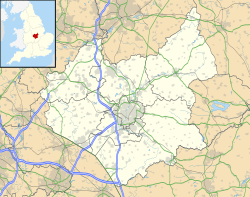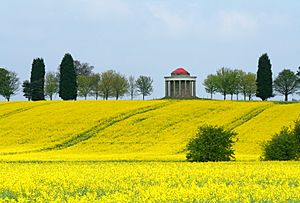Garendon Abbey facts for kids
| Monastery information | |
|---|---|
| Order | Cistercian |
| Established | 1133 |
| Disestablished | 1536 |
| People | |
| Founder(s) | Robert de Beaumont, 2nd Earl of Leicester |
| Site | |
| Location | Between Shepshed and Loughborough, in Leicestershire, England |
| Coordinates | 52°46′27″N 1°15′31″W / 52.7743°N 1.2585°W |
| Visible remains | Foundations of Chapter house visible but on private land. |
Garendon Abbey was an old Cistercian abbey located near the towns of Shepshed and Loughborough in Leicestershire, United Kingdom. An abbey is a special type of monastery where monks or nuns live under the guidance of an abbot or abbess. This abbey was a home for Cistercian monks, who followed a strict religious life.
Contents
History of Garendon Abbey
Garendon Abbey was started in 1133 by a powerful nobleman named Robert de Beaumont, 2nd Earl of Leicester. It was likely a "daughter house" of Waverley Abbey in Surrey, meaning it was founded by monks from that abbey. Robert de Beaumont was very generous. He gave the abbey a lot of land, about 690 acres in Garendon itself. He also gave them a special property in Leicester called a Burgage tenement, which was like a town plot. More land was given in places like Dishley, Shepshed, and Ringolthorpe.
Growing the Abbey's Lands
Within about 100 years, the abbey became even richer. It gained more land in many parts of Leicestershire, including Burton on the Wolds, Eastwell, Ibstock, Stanton under Bardon, and Welby. They also got land in Costock, Nottinghamshire, and Heathcote, Derbyshire.
The monks then set up special farms called granges near the abbey and in these new areas. These granges were like large farms run by the monks or their workers. Through these granges, Garendon Abbey became very good at raising sheep. They had a huge number of sheep, which helped them earn a lot of money.
Garendon Abbey also helped start two other monasteries. These were Biddlesden Abbey in Buckinghamshire and Bordesley Abbey in Worcestershire.
Tough Times for the Abbey
Even with all its land and wealth, the abbey faced difficulties by the late 1200s. It owed a lot of money, about £120, which was a huge sum back then. In 1295, King Edward I had to step in. He appointed a "special keeper" to manage the abbey's money and help them get out of debt.
Despite the king's help and the abbey's large gifts of land, its money problems seemed to continue. By 1535, the abbey's yearly income was recorded as only about £100. It was also noted that the "large old monastery was partly ruinous," meaning parts of it were falling apart.
The End of Garendon Abbey
Garendon Abbey was eventually closed down in 1536. This happened during the time of King Henry VIII, who decided to close many monasteries in England. This event is known as the Dissolution of the monasteries. The king closed the smaller monasteries, which were those earning less than £200 a year. The abbot, who was the head of the monastery, was given a yearly payment of £30.
After the Abbey Closed
After the abbey was closed, its main church was completely torn down. The other buildings where the monks lived, which were already partly ruined, were left to fall apart even more.
The king then sold the abbey's land to Thomas Manners, 1st Earl of Rutland, for a large sum of money. The Earl of Rutland then built a new house on the abbey site. This house became known as Garendon House. The Earls of Rutland owned this house until 1632. It then became part of the dowry (a gift of property or money given to a husband by his wife's family) for Lady Katherine Manners when she married George Villiers, 1st Duke of Buckingham. In 1640, the estate was valued at £5,648 and had over 13,000 trees.
Changes to Garendon House
In 1684, the 2nd Duke of Buckingham sold Garendon House to Sir Ambrose Phillipps, a successful lawyer. Sir Ambrose and his son didn't change the house much. But his grandson, also named Ambrose Phillipps, was an architect who loved the buildings he saw on his travels in France and Italy.
Starting in 1734, Ambrose began to transform the land around the house. He created beautiful gardens and built several Palladian follies. These "follies" were decorative buildings, like small temples or ruins, built just for looks in the park. Many of them still stand today. Ambrose also started to redesign and expand Garendon House itself in the Palladian style, turning it into what would be called Garendon Hall. However, he died in 1737 before the work was finished. His brother Samuel completed the project.
Later Years and Demolition
After Ambrose's death, the family faced financial difficulties. In 1885, they moved out of Garendon Hall and into another house called Grace Dieu Manor. They were able to return to Garendon Hall in 1907 when their money situation improved.
During the Second World War, the army used Garendon Hall, and it was badly damaged. The cost of keeping the huge house in good condition became too high. Also, the nearby town of Loughborough was growing, and the new M1 Motorway was planned to cut right through the park. Because of these reasons, it was decided that the house should be torn down.
In June 1964, Garendon Hall was deliberately set on fire. This was done to give the local fire brigade practice and training. The house was then reduced to rubble. This rubble was then used to help build the nearby M1 motorway.
In 1964, the family moved back to Grace Dieu Manor for a short time. They sold that house within ten years. It later became a Catholic school. In 1972, the family moved to Quenby Hall. However, after their family cheese-making business failed, they have had to try and sell Quenby Hall since 2012.
Layout and Remains of the Abbey
Historians believe that Garendon Abbey was a very large complex, covering an area of about 70 meters by 80 meters. St Bernard of Clairvaux, one of the important figures in the Cistercian Order, believed that church buildings should be simple. He didn't like fancy decorations or sculptures. Because of this, Cistercian buildings were often very plain and simple in their design.
After the abbey was closed, Garendon Hall was built right on top of where the abbey church used to be. The hall's cellars used some of the original stone from the 13th-century abbey. These cellars also had two "stone lined wells."
After Garendon Hall was torn down, archaeologists were able to dig up the site of the old abbey. Between 1966 and 1968, they found the foundations of the abbey's chapter house and dormitory. The chapter house was a room where the monks met for important discussions. They also found parts of the chapels that were attached to the abbey church. It was also discovered that the abbey's old drain system was used as part of Garendon Hall's sewage system.
Today, the remains of the chapter house and drains are still visible, but they are on private land. These ruins, along with the surrounding area and the old fishponds used by the monks, are protected as Scheduled Ancient Monuments. This means they are important historical sites that are preserved by law.
See also
- Garendon Hall



